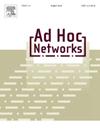Energy-efficient Nonuniform Cluster-based Routing Protocol with Q-Learning for UASNs
IF 4.4
3区 计算机科学
Q1 COMPUTER SCIENCE, INFORMATION SYSTEMS
引用次数: 0
Abstract
Underwater Acoustic Sensor Networks (UASNs) are widely used in various fields. The limited energy of underwater nodes and the difficulty of replenishment constrain the lifetime of UASNs. Thus, it is important to effectively balance energy consumption and design a routing protocol that ensures efficient data transmission and extends network lifetime. Cluster routing protocol is widely recognized as an energy efficient strategy for UASNs. However, it faces challenges including “hotspot” issues caused by nodes frequently acting as cluster heads (CHs) and forwarding packets, as well as energy inefficiency resulting from packet conflicts and redundant transmissions. Therefore, we propose an Energy-efficient Nonuniform Cluster-based Routing Protocol with Q-Learning (ENCRQ) to balance energy consumption and improve packet forwarding efficiency. In the CH election phase, a “CH competitiveness” function is created based on node weighted density and residual energy. Nodes outside the sink neighborhood adaptively compete for CHs based on this function, aiming to achieve an uneven distribution of CHs and balance energy consumption. Meanwhile, nodes within the sink neighborhood remain sleeping to further reduce energy consumption. In the inter-cluster routing phase, the forwarding area is hierarchically divided based on node depth and distance to the sink node. The optimal forwarding area is adaptively adjusted to form the next-hop candidate set. On this basis, holding time is designed for candidate nodes based on Q-Learning technique to prioritize forwarding, minimizing packet conflicts and redundant transmissions, thereby enhancing network transmission efficiency. Simulation results show that compared with LEACH, QELAR and QHUC, ENCRQ has significant improvement in terms of network lifetime, energy balance and energy efficiency.
基于q -学习的高效非均匀集群路由协议
水声传感器网络(uasn)广泛应用于各个领域。水下节点能量的有限性和补给的难易性制约了uasn的寿命。因此,如何有效地平衡网络能耗,设计一种既能保证数据传输效率又能延长网络生命周期的路由协议就显得尤为重要。集群路由协议被广泛认为是一种高效节能的组网策略。然而,它面临的挑战包括节点频繁充当簇头(CHs)和转发数据包导致的“热点”问题,以及数据包冲突和冗余传输导致的能源效率低下。为此,我们提出了一种基于Q-Learning的节能非均匀集群路由协议(ENCRQ),以平衡能量消耗,提高数据包转发效率。在CH选举阶段,基于节点加权密度和剩余能量创建“CH竞争”函数。sink邻域外的节点基于该函数自适应竞争CHs,以达到CHs分布不均匀和能量消耗平衡的目的。同时,sink邻居内的节点保持休眠状态,以进一步降低能耗。在集群间路由阶段,根据节点深度和到汇聚节点的距离对转发区域进行分层划分。自适应调整最优转发区域,形成下一跳候选集。在此基础上,基于Q-Learning技术设计候选节点保持时间,优先转发,减少报文冲突和冗余传输,提高网络传输效率。仿真结果表明,与LEACH、QELAR和QHUC相比,ENCRQ在网络寿命、能量平衡和能量效率方面都有显著提高。
本文章由计算机程序翻译,如有差异,请以英文原文为准。
求助全文
约1分钟内获得全文
求助全文
来源期刊

Ad Hoc Networks
工程技术-电信学
CiteScore
10.20
自引率
4.20%
发文量
131
审稿时长
4.8 months
期刊介绍:
The Ad Hoc Networks is an international and archival journal providing a publication vehicle for complete coverage of all topics of interest to those involved in ad hoc and sensor networking areas. The Ad Hoc Networks considers original, high quality and unpublished contributions addressing all aspects of ad hoc and sensor networks. Specific areas of interest include, but are not limited to:
Mobile and Wireless Ad Hoc Networks
Sensor Networks
Wireless Local and Personal Area Networks
Home Networks
Ad Hoc Networks of Autonomous Intelligent Systems
Novel Architectures for Ad Hoc and Sensor Networks
Self-organizing Network Architectures and Protocols
Transport Layer Protocols
Routing protocols (unicast, multicast, geocast, etc.)
Media Access Control Techniques
Error Control Schemes
Power-Aware, Low-Power and Energy-Efficient Designs
Synchronization and Scheduling Issues
Mobility Management
Mobility-Tolerant Communication Protocols
Location Tracking and Location-based Services
Resource and Information Management
Security and Fault-Tolerance Issues
Hardware and Software Platforms, Systems, and Testbeds
Experimental and Prototype Results
Quality-of-Service Issues
Cross-Layer Interactions
Scalability Issues
Performance Analysis and Simulation of Protocols.
 求助内容:
求助内容: 应助结果提醒方式:
应助结果提醒方式:


